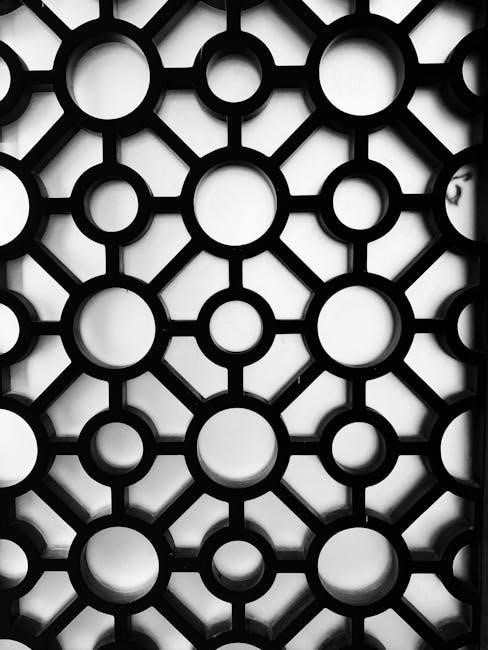concepts and formulas precisely always.
Definition and Classification
Bravais lattices are defined as infinite periodic arrays of discrete points in space generated by discrete translation operations, which can be classified into different types based on their symmetry properties. The classification of Bravais lattices is a fundamental concept in crystallography, and it is used to describe the arrangement of atoms in a crystal structure. According to the definition, Bravais lattices can be classified into different categories, including primitive and non-primitive lattices, and each category has its own unique characteristics. The classification of Bravais lattices is based on the symmetry operations that leave the lattice invariant, and it is an important tool for understanding the properties of crystals. Using mathematical concepts and formulas, the definition and classification of Bravais lattices can be precisely determined, and this information can be found in various online resources, including pdf files and academic articles.
Properties of Bravais Lattices
Properties of Bravais lattices include periodicity and symmetry using mathematical concepts always precisely defined online.
Point Lattices and Symmetry Properties
Point lattices are classified according to their symmetry properties, which are determined by the arrangement of points in space. The symmetry properties of a point lattice are described by its point group, which is a set of symmetry operations that leave the lattice unchanged. The point group of a lattice is determined by the arrangement of points in space and the symmetry operations that can be applied to the lattice. The symmetry properties of point lattices are important in understanding the properties of crystals and other materials. The point lattice is a fundamental concept in crystallography and is used to describe the arrangement of atoms in a crystal. The symmetry properties of point lattices are used to classify crystals into different types, such as cubic, tetragonal, and orthorhombic. Using online resources, researchers can study point lattices and their symmetry properties in detail.

Types of Bravais Lattices
There are several types of Bravais lattices, including 1D and 2D lattices, each with unique properties always precisely.
1D, 2D, and 3D Bravais Lattices
In one dimension, there is only one Bravais lattice, which can be thought of as a series of equally spaced points on a line, defined by a single unit vector. In two dimensions, there are five Bravais lattices, including the square and hexagonal lattices, each with its own unique symmetry properties. The 2D Bravais lattices can be classified into different types based on their symmetry operations, including rotation and reflection. In three dimensions, there are 14 possible Bravais lattices, which can be classified into seven crystal systems, including the cubic, tetragonal, and orthorhombic systems. Each of these systems has its own unique properties and characteristics, and can be used to describe the structure of different types of crystals. The study of Bravais lattices is important for understanding the properties of materials.

Crystallographic Point Groups
Crystallographic point groups are used to classify crystals based on their symmetry properties and operations precisely always in crystallography studies and research papers online.
Relation to the Seven Crystal Systems
The relation to the seven crystal systems is a fundamental concept in crystallography, where each crystal system is defined by its own unique set of symmetry elements and operations. The seven crystal systems are triclinic, monoclinic, orthorhombic, tetragonal, trigonal, hexagonal, and cubic, each with its own distinct characteristics and properties; These crystal systems are used to classify crystals based on their external symmetry, and are related to the 32 point groups and 14 Bravais lattices. The crystal systems are also used to describe the internal symmetry of crystals, and are an essential tool in understanding the structure and properties of materials. By using crystallographic techniques and methods, researchers can determine the crystal system of a material and gain insights into its properties and behavior. This knowledge is essential in a wide range of fields, from materials science to chemistry and physics.

Space Groups and Bravais Lattices
Space groups combine point groups and Bravais lattices to describe crystal symmetry using math concepts and formulas precisely always in crystallography studies and research papers online.
Combining Point Groups and Bravais Lattices
Combining point groups and Bravais lattices is a fundamental concept in crystallography, allowing for the description of crystal symmetry. The 32 point groups are combined with the 14 Bravais lattices to form 230 space groups, which are used to classify crystals. This combination enables the determination of the symmetry operations that leave the crystal invariant. The point group symmetry is combined with the translational symmetry of the Bravais lattice to form the space group. The resulting space group describes the overall symmetry of the crystal, including the arrangement of atoms and molecules. This information is crucial in understanding the properties and behavior of crystals, and is used in a wide range of fields, including materials science, physics, and chemistry, with references to scientific studies and research papers available online.

Applications of Bravais Lattices
Bravais lattices have numerous applications in materials science and physics fields always precisely.
Importance of Bravais Lattices in Crystallography
The importance of Bravais lattices in crystallography is significant as they provide a framework for understanding the symmetry and structure of crystals, which is crucial in determining their physical and chemical properties. The use of Bravais lattices allows researchers to classify crystals into different categories based on their symmetry and lattice parameters. This classification is essential in predicting the behavior of crystals under various conditions, such as temperature and pressure. Furthermore, Bravais lattices are used to determine the arrangement of atoms within a crystal, which is vital in understanding the crystal’s electronic and optical properties. The application of Bravais lattices in crystallography has led to numerous breakthroughs in materials science and physics, and continues to be an active area of research. Using online resources, researchers can access information on Bravais lattices and their applications in crystallography.
